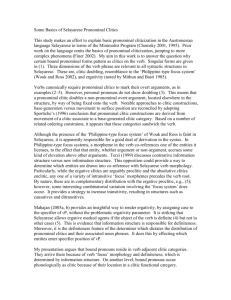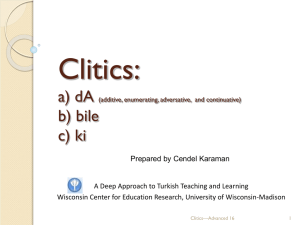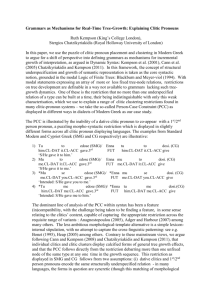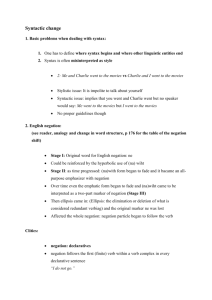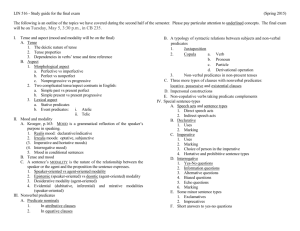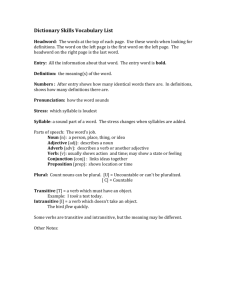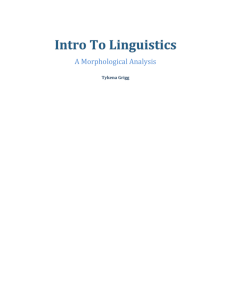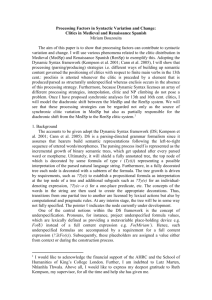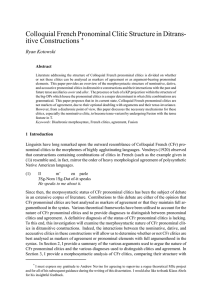Handout
advertisement
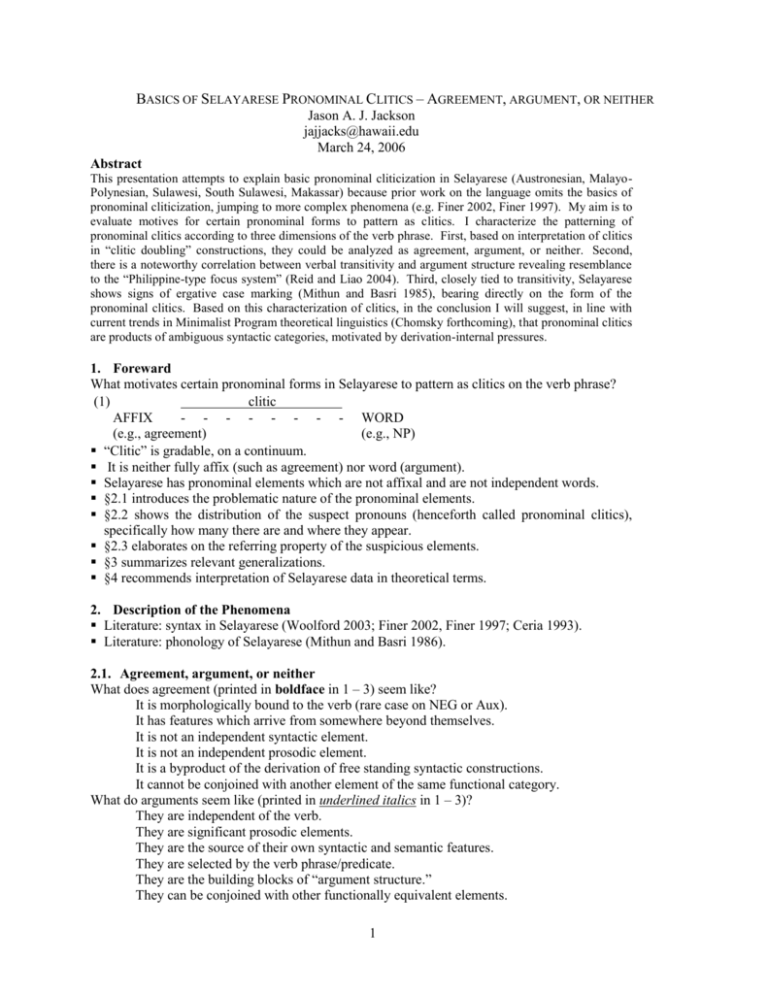
BASICS OF SELAYARESE PRONOMINAL CLITICS – AGREEMENT, ARGUMENT, OR NEITHER Jason A. J. Jackson jajjacks@hawaii.edu March 24, 2006 Abstract This presentation attempts to explain basic pronominal cliticization in Selayarese (Austronesian, MalayoPolynesian, Sulawesi, South Sulawesi, Makassar) because prior work on the language omits the basics of pronominal cliticization, jumping to more complex phenomena (e.g. Finer 2002, Finer 1997). My aim is to evaluate motives for certain pronominal forms to pattern as clitics. I characterize the patterning of pronominal clitics according to three dimensions of the verb phrase. First, based on interpretation of clitics in “clitic doubling” constructions, they could be analyzed as agreement, argument, or neither. Second, there is a noteworthy correlation between verbal transitivity and argument structure revealing resemblance to the “Philippine-type focus system” (Reid and Liao 2004). Third, closely tied to transitivity, Selayarese shows signs of ergative case marking (Mithun and Basri 1985), bearing directly on the form of the pronominal clitics. Based on this characterization of clitics, in the conclusion I will suggest, in line with current trends in Minimalist Program theoretical linguistics (Chomsky forthcoming), that pronominal clitics are products of ambiguous syntactic categories, motivated by derivation-internal pressures. 1. Foreward What motivates certain pronominal forms in Selayarese to pattern as clitics on the verb phrase? (1) clitic AFFIX - - - - - - - - WORD (e.g., agreement) (e.g., NP) “Clitic” is gradable, on a continuum. It is neither fully affix (such as agreement) nor word (argument). Selayarese has pronominal elements which are not affixal and are not independent words. §2.1 introduces the problematic nature of the pronominal elements. §2.2 shows the distribution of the suspect pronouns (henceforth called pronominal clitics), specifically how many there are and where they appear. §2.3 elaborates on the referring property of the suspicious elements. §3 summarizes relevant generalizations. §4 recommends interpretation of Selayarese data in theoretical terms. 2. Description of the Phenomena Literature: syntax in Selayarese (Woolford 2003; Finer 2002, Finer 1997; Ceria 1993). Literature: phonology of Selayarese (Mithun and Basri 1986). 2.1. Agreement, argument, or neither What does agreement (printed in boldface in 1 – 3) seem like? It is morphologically bound to the verb (rare case on NEG or Aux). It has features which arrive from somewhere beyond themselves. It is not an independent syntactic element. It is not an independent prosodic element. It is a byproduct of the derivation of free standing syntactic constructions. It cannot be conjoined with another element of the same functional category. What do arguments seem like (printed in underlined italics in 1 – 3)? They are independent of the verb. They are significant prosodic elements. They are the source of their own syntactic and semantic features. They are selected by the verb phrase/predicate. They are the building blocks of “argument structure.” They can be conjoined with other functionally equivalent elements. 1 Agreement and argument are typified in e.g. English and Italian (2a-4b) (2) (3) (4) English (a) I talk. You and your child talk. Brutus talks. Italian (b) (Io) parlo. ~ Parlo (io). Lei e la sua figlia parlano. Caesar parle. Strict agreement/argument distinction fails to capture the Selayarese pronominal clitic data. Pronominal elements are bound in Selayarese phonology (Mithun and Basri 1986). E.g., lowering effect if there is a word final mid vowel (see 5a); the clitic -ko enables lowering. (5) Final mid vowel lowering (for the sake of discourse, rule based derivational schemata has been adapted from Mithun and Basri 1986): the symbol ‘’ after a vowel (e.g. [o]) indicates the vowel is slightly lower than canonical [o]. (a) (b) Underlying /to-/ + /lo:lo/ /to-/ + /lo:lo/ + /-mo/ + /-i/ Gloss 3Rel + young.lady 3Rel + yng.lady + TMA + 3Abs Final lowering to-lo:lo to-lo:lo-mo-i Anticipatory lowering to-lo:lo --Phonetic form [tolo:lo] [tolo:lomo(i)] ‘is a young lady’ ‘has just become a young lady’ Although bound, it is not clear if the clitics are agreement or argument (see Otsuka 2002). Pronominal clitics do not strictly attach to the verb (compare (6a) with (6b) and (8) with (9)). (6a) Intransitive verb V=S po:re-a skillful-1Abs ‘I am skillful.’ (6b) Negative plus intransitive verb NEG=S V ge:le-a po:re NEG-1Abs skillful ‘I am not skillful.’ (7) Object incorporation verb V=S A’-cidong-kadera-a INTR-sit-chair-1Abs ‘I chair-sit.’ (8) Intransitive verb V=S n-rio-ko INTR-bathe-2fAbs ‘you (familiar) bathe.’ (9) Auxiliary and an intransitive verb AUX=S V la-maŋe-ko n-rio TMA-go-2fAbs INTR-bathe ‘you (familiar) will bathe.’ (Mithun and Barsri 1986) (Mithun and Barsri 1986) (Finer 1997) (Mithun and Barsri 1986) (Mithun and Barsri 1986) (6–9) shows that the clitic attaches to the initial element in the clause 2 Reinforcing data for the general pattern identified in (6-9) comes from Lakiung (cited as Manyambeang et al. 1996) and Konjo (cited as Friberg 1991), which are also dialects of Makassarese. These data speak for the dialect chain which contains Selayarese. (10a) In a stative construction, the clitic appears on the initial element: V=CL [S ] kanang-kanang-i tanjak-na (Manyambeang et al. 1996) beautiful-REDUP-1Abs appearance-3G ‘Her appearance is beautiful.’ (10b) Initial degree adverb hosts clitic: Adv=CL V [S ] Sannak-i kanang-kanan-na tanjak-na (Manyambeang et al. 1996) very-3Abs beautiful-REDUP-3G appearance-3G ‘Her appearance is very beautiful.’ (10c) In a construction with an adverb, clitic appears dependent on initial element: V=CL Adv a’-inro-a ita’ (Friberg 1991) INTR-return-1Abs quick ‘I will return quickly.’ (10d) If the adverb is in initial position, it hosts the clitic: Adv=CL V ita’-ko a’-inro (Friberg 1991) quickly-2fAbs INTR-return ‘Return quickly.’ (10e) Initial locative adverb appears as host for clitic: Adv=CL V konjo-a ang-jama (Friberg 1991) there-1Abs AFT-work ‘It is over there I work.’ Selayarese pronominal clitics not always doubled. Can be the only referential element in a construction (5-8). Pronominal elements are not independent words. Separate sets of emphatic and independent pronouns (see the appendix). Emphatic pronouns never co-occur with pronominal clitics. Pronominal clitics do not show phonological properties demonstrated by affixes (e.g., epenthesis, V-lowering (5a, 5b), and stress shift (Mithun and Basri 1986)). (5b) illustrates that even when clitic pronouns have been deleted from the surface phonetic form, they are nevertheless present in the derivation. Agreement is obligatory, it can never be dropped. Arguments may be dropped. Conclusion, Selayarese clitics are obligatory, but neither fully agreement nor fully argument. 2.2. Transitivity and the pronominal clitics How many pronominal clitics are there? Where do they occur? All sentences have a predicate. The predicate selects one (monadic), two (dyadic), or three (triadic) arguments. These arguments take part in the event, state, equation, etc., denoted by the predicate. Intransitive : transitive distinction best viewed as a continuum (Hopper and Thompson 1980). 3 (11a) Abs clitic is thematic, the sole (S) argument of a (unaccusative) one-place intransitive. V=S po:re-a (Mithun and Basri 1986) skillful-1Abs ‘I am skillful.’ (11b) Abs clitic for agentive S of (unergative) one-place intransitive. V=S (Mithun and Basri 1986) a’-botór-o-a INTR-gamble-Ø-1Abs ‘I gamble.’ Evidence based on intransitives (11) is unclear; theme and agent are marked alike. Transitive constructions make distinction between themes and agents. Problem: some “intransitives” (12), have O or Obl without clitic counterpart. (12a) Sole marker for agent of antipassive (two-place intransitive). Indefinite O. V=(A?/S?) [(O?)] ’a-mu:no-a ’a:su (Mithun and Basri 1986) INTR-kill-1Abs dog ‘I killed a dog.’ *‘I killed the dog.’ (12b) One-place intransitive with (optional/adjunct) oblique, Abs S. V=S [OBL ] aŋ-tá:ma’-a (ri sapo) (Mithun and Basri 1986) INTR-enter-1Abs PREP house ‘I entered (into) a house.’ (11 – 12) is reminiscent of the “Philippine-type focus system. Additional argument (O or Obl) must not be definite. (13a) Two-place transitive, two clitics (one for A, one for O; but, see also Woolford 2003). A=V=O la-ra:buŋ-a (Mithun and Basri 1986) 3Erg-hit-1Abs ‘he hit me.’ or ‘(by) him, hit, I (was).’ (13b) Two clitics for two-place transitive. O is definite. A=V=O [O ] [A ] la-’alle-i doe’-injo ’i Baso (Finer 2002) 3Erg-took-3Abs money-Det Prsn.Mrkr Baso ‘Baso took the money.’ Based on distribution and number of clitics, absolutive case and definiteness seem related. 2.3. the ergative-absolutive pattern “Ergative-absolutive” pattern is a marking where S and O are alike (Dixon 1994). Absolutive is the frequent/unmarked case. (14) Intransitive with absolutive S (previously 11b). V=S a’-botór-o-a INTR-gamble-Ø-1Abs ‘I gamble.’ 4 (Mithun and Basri 1986) (15) Transitive, ergative A, and absolutive O (previously 13b). A=V=O [O ] [A ] la-’alle-i doe’-injo ’i Baso (Finer 2002) 3Erg-took-3Abs money-Det Prsn.Mrkr Baso ‘Baso took the money.’ (16) Antipassive with absolutive (S) agent but no clitic for the (O) element (prior 12a). V=S [(Obl/O?)] ’a-mu:no-a (’a:su) (Mithun and Basri 1986) INTR-kill-1Abs dog ‘I killed (a dog).’ Case marking indicates which pronominal clitic references which noun phrase. 3. Generalizations Pronominal elements in Selayarese must be syntactic elements, i.e. clitics. Problem: clitics are not singly syntactic. Towards an answer: relation between verbal affixes and definiteness needs to be identified (17) Also need to anticipate the ergative case marking pattern (18) (17) Definiteness effect: Two-place transitive, type 1: affix (ergative) object [+def]. Two-place transitive, type 2: affix (antipassive) oblique/object [-def]. (18) Predicting the form of clitics (the ergative pattern): Type 1 transitive affixes agent (A) is ergative, object (O) is absolutive. Type 2 transitive (antipassive) affixes agent (S) is absolutive (demoted from transitive A). Summary: clitic is not a homogeneous category. It is a band of neighboring positions on a continuum (see 1). 4. Conclusion Data supports Reid and Liao’s (2004) analysis of Philippine-type languages. How relate the description to theoretical issues? a) How should constructions in Selayarese with two instantiations of a single referent be handled (Bošković 2004; Sportiche 1996)? b) Where does each expression originate? c) If clitics are analyzed as arguments, the full forms must be non-argument positions (evidence for this is lacking). How does this work (Larson 1988)? d) On the other hand, if they are agreement, how explanation their distribution (Chomsky forthcoming), “ergative” case marking (Mahajan 2005a,b) and the definiteness constraints (Terzi 1999). e) What mechanism drives the second position phenomenon (Bošković 2000)? Answers to these questions will help determine a formal account of complex structures (19): (19) Multiple clauses, multiple clitics and wh- fronting. (Finer 1997) A3 A1=V1 [ A2=V2=O2 [ A1=V3=O3(S3)[O3 ]]O2 ]O1 Inai mu-kua(*-i) muko to-isse’-i toko la-’alle-i doe’ injo Who 2fErg-say Comp 1PlErg-know-3Abs Comp 3Erg-take-3Abs money Det ‘WhoA3 did youA1 sayV1 weA2 knowV2 tookV3 the moneyO3?’ 5 Singular 1 2f 2h 3 Plural 1n 1x APPENDIX – SELAYARESE PRONOUNS AND VERBALIZERS Posv Emf Prn Indp Prn # Vbsr Erg Abs kumurila- -a -ko -ki -i -ku -mu -ta -na rito- -ki -kaŋ -ta -ba nakke ?(i)ditte? (‘i)ka:u (‘i)ka:u a’nataapa - INTR, [-DEF] object INTR Patient (un-ergative) INTR/TRN Causitivizer REFERENCES BOŠKOVIĆ, ŽELJKO. 2004. Clitics as nonbranching elements and the Linear Correspondence Axiom. Natural Language and Linguistic Theory 23:29–40. ———. 2000. Second position cliticisation: Syntax and/or phonology? In: Clitic phenomena in European languages, ed. by Marcel den Dikken and Frits Beukema, 71–119. Philadelphia: John Benjamins. CERIA, VIRGINIA G. 1993. Verb morphology and valence change in Selayarese. In: University of Pittsbugh Working Papers in Linguistics, ed. by G. Coelho and D. Everett, 76–185. University of Pittsburgh Press: Pittsburgh. CHOMSKY, NOAM. Forthcoming. On phases. MS. DIXON, ROBERT, M. W. 1994. Ergativity. Cambridge: Cambridge University Press. FINER, DANIEL. 2002. Phases and movement in Selayarese. In: MIT Working Papers in Linguistics 44, Proceedings of the Austronesian Formal Linguistics Association 8, ed. by Andrea Rackowski and Norvin Richards, 157–69. ———. 1997. Contrasting Ā-dependencies in Selayarese. Natural Language and Linguistic Theory 15:677–728. FRIBERG, BARBARA. 1991. Ergativity, focus and verb morphology in several South Sulawesi languages. In: Western Austronesian and Contact Languages: Papers from the Fifth International conference on Austronesian Linguistics, ed. by Ray Harlow and Ross Clark, 103–30. Auckland: Linguistic Society of New Zealand. HOPPER, PAUL and THOMPSON, SANDRA. 1980. Transitivity in grammar and discourse. Language 56(2): 251–299. LARSON, RICHARD. 1988. On the double object construction, Linguistic Inquiry 19:335–92. MAHAJAN, ANOOP. 2005a. Ergatives, passives and other oblique subject constructions. Seminar handout. University of Hawai‘i at Mānoa. ———. 2005b. The syntactic basis of ergativity. Seminar handout. University of Hawai‘i at Mānoa. MANYAMBEANG, ABD. KADIR; ABDUL KADIR MULYA; NASRUDDIN. 1996. Tata Bahasa Makassar. Jakarta: Pusat Pembinaan dan Pengembangan Bahasa Departemen Pendidikan dan Kebudayaan. MITHUN, MARIANNE, and HASAN BASRI. 1986. The phonology of Selayarese. Oceanic Linguistics 25 (1-2):210–54. OTSUKA, YUKO. 2002. Split ergativity and the nature of pronouns in Tongan. In: MIT Working Papers in Linguistics 44, Proceedings of Austronesian Formal Linguistics Association 8, ed. by Andrea Rackowski and Norvin Richards,197–210. REID, LAWRENCE A., and HSIU-CHUAN LIAO. 2004. A brief syntactic typology of Philippine languages. Language and Linguistics 5(2):433–490 SPORTICHE, DOMINIQUE. 1996. Clitic constructions. In: Phrase structure and the lexicon, ed. by J. Rooryck and L. Zaring, 213–277. Dordrecht: Kluwer. TERZI, ARHONTO. 1999. Clitic combinations, their hosts and their ordering. Natural Language and Linguistic Theory 17:85–121. Woolford, Ellen. 2003. Clitics and Agreement in Competition: Ergative cross-referencing patterns. In: Papers in Optimality Theory II, ed. by A. Carpenter et al. GLSA: Amherst www.ethnologue.com/show_language.asp?code=sly 6
